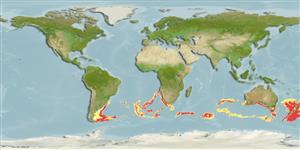>
Myctophiformes (Lanternfishes) >
Myctophidae (Lanternfishes) > Gymnoscopelinae
Etymology: Gymnoscopelus: Greek, gymnos = naked + Greek, skopelos, a lantern fish (Ref. 45335).
More on author: Whitley.
Environment: milieu / climate zone / depth range / distribution range
Ökologie
seewasser benthopelagisch; ozeanodrom (Ref. 51243). Temperate; 19°S - 62°S, 70°W - 180°E
Generally ranges between the Subtropical Convergence and the Antarctic Polar Front (Atlantic Sector to south of Australia/New Zealand), but with northern extensions in eastern boundary currents; absent in the sub-Antarctic region of the Pacific. There is a beach-washed specimen from Port Alfred, South Africa (Ref. 4066). Also found in Argentina (Ref. 86326) and Uruguay (Ref. 54736).
Length at first maturity / Size / Gewicht / Alter
Maturity: Lm ?, range 10 - ? cm
Max length : 14.6 cm SL Männchen/unbestimmt; (Ref. 5182)
Rückenflossenstacheln (insgesamt): 0; Rückenflossenweichstrahlen (insgesamt): 18-20; Afterflossenstacheln 0; Afterflossenweichstrahlen: 16 - 19
Oceanic (Ref. 4066). Also mesopelagic. Occurs at depths below 100 m at night. Recorded from the stomach contents of Dissostichus eleginoides.
Life cycle and mating behavior
Geschlechtsreife | Fortpflanzung | Ablaichen | Eier | Fecundity | Larven
Hulley, P.A., 1990. Myctophidae. p. 146-178. In O. Gon and P.C. Heemstra (eds.) Fishes of the Southern Ocean. J.L.B. Smith Institute of Ichthyology, Grahamstown, South Africa. (Ref. 5182)
IUCN Rote Liste Status (Ref. 130435)
Bedrohung für Menschen
Harmless
Nutzung durch Menschen
Mehr Information
Alter/GrößeWachstumLänge-GewichtLänge-LängeLängenhäufigkeitenMorphometrieMorphologieLarvenLarven Pop.Dyn.RekrutierungDichteBRUVS
ReferenzenAquakulturAquakultur ProfilZuchtlinienGenetikElectrophoresesVererbbarkeitKrankheitenVerarbeitungNutrientsMass conversion
PartnerBilderStamps, Coins Misc.LauteCiguateraGeschwindigkeitSchwimmstilKiemenoberflächeOtolithsGehirngrößeSehfähigkeit
Tools
Zusatzinformationen
Download XML
Internet Quellen
Estimates based on models
Preferred temperature (Ref.
123201): 1.9 - 9.5, mean 4.6 °C (based on 783 cells).
Phylogenetic diversity index (Ref.
82804): PD
50 = 0.5039 [Uniqueness, from 0.5 = low to 2.0 = high].
Bayesian length-weight: a=0.00437 (0.00199 - 0.00957), b=3.16 (2.96 - 3.36), in cm total length, based on LWR estimates for this (Sub)family-body shape (Ref.
93245).
Trophic level (Ref.
69278): 3.2 ±0.5 se; based on size and trophs of closest relatives
Widerstandsfähigkeit (Ref.
120179): mittel, Verdopplung der Population dauert 1,4 - 4,4 Jahre. (Preliminary K or Fecundity.).
Fishing Vulnerability (Ref.
59153): Low vulnerability (10 of 100).
